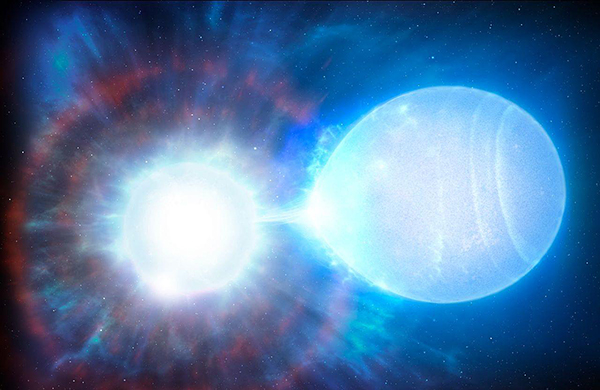
22 Apr 2025
Published in Nature Astronomy, a team of international astronomers has discovered the highest total mass double white dwarf binary to date, located a mere 160 light years away from the Sun. Coming in at approximately 1.56 solar masses, the source is the first double white dwarf destined to undergo unstable mass transfer and explode as a type Ia supernova.
White dwarfs are the stripped cores of low and intermediate mass stars, inevitably the fate of our Sun. When two stars form close together from the same molecular cloud, mass transfer phases can lead to a very compact orbit being maintained on the timescale of hours to days while the stars have evolved to both become white dwarfs. These double white dwarf binaries are cosmologically important as the long-expected progenitors of type Ia supernovae, which drive Galactic evolution from enrichment of the interstellar medium with heavy elements.
Type Ia supernovae typically occur when a white dwarf gains mass from its companion and exceeds the Chandrasekhar mass limit (1.4 solar masses), though studies have shown that, under the right conditions, a surface detonation can trigger the entire white dwarf to explode at significantly smaller masses too.
A large survey on the William Herschel Telescope (WHT) led by James Munday, ex-student at the Isaac Newton Group of Telescopes (ING) and PhD researcher at the University of Warwick, strives to detect many new and high-mass double white dwarfs.
This new system is in fact the heaviest of its type ever confirmed, with a combined mass of 1.56 times that of the Sun. Given this high mass, no matter what, the stars are destined to explode. The explosion is not due for another 23 billion years, however.
"A long-standing problem is the need to prove double white dwarfs as the origin of type Ia supernovae, however no Galactic systems had hitherto been discovered that would one day explode as a type Ia. Discovering that the two stars are separated by just 1/60th of the Earth-Sun distance and combine to a mass of 1.56 solar masses, we quickly realised that not only did we find the first double white dwarf that will inevitably detonate, but that it will do so relatively near the Sun, and when the Universe will be under just three times its present age. Overall, this means that we can now account for a few percent of the Milky Way type Ia rate with confidence", James explained.
As part of the study, the team simulated the supernova event (video animation below). Right now, the white dwarfs are leisurely spiralling around each other in an orbit taking longer than 14 hours. Over billions of years, gravitational wave radiation will cause the two stars to inspiral until, at the precipice of the supernova event, they will be moving so fast that they complete an orbit in a mere 30 – 40 seconds.
The leading expectation is that the two stars will not merge, but a surface thermonuclear detonation will set off a larger explosion of the more massive star in its core. This eruption will launch matter in all directions at great speed, and when this material hits the companion it will cause the whole process to repeat, leading to the third and fourth explosion, ending as a complete destruction of the system through these back-to-back double detonation events. At Earth, the explosion would appear 200,000 times brighter than Jupiter.
Having radial velocity amplitudes of 10s to 100s of kilometres per second, the double white dwarfs are perfect to be studied with medium resolution spectrographs. The team first discovered the system on the WHT with the Intermediate-dispersion Spectrograph and Imaging System (ISIS) before employing the Intermediate Dispersion Spectrograph (IDS) on the Isaac Newton Telescope (INT), along with other telescopes worldwide, to precisely resolve its orbital period and confirm the masses of each star.
Many other interesting systems were identified in their double-lined double white dwarf (DBL) survey (Munday, 2024) and the search for more high total mass systems continues. Furthermore, over its lifetime, the WEAVE spectrograph on the WHT is set to observe thousands of white dwarfs, many for the first time spectroscopically. Its vast data archive will prove to be a powerful tool in identifying binary systems with compact orbits through radial velocity variability, perhaps revealing more type Ia progenitors on its journey.
[Image]
Artist's impression of a binary system in which its two stars are about to collide
